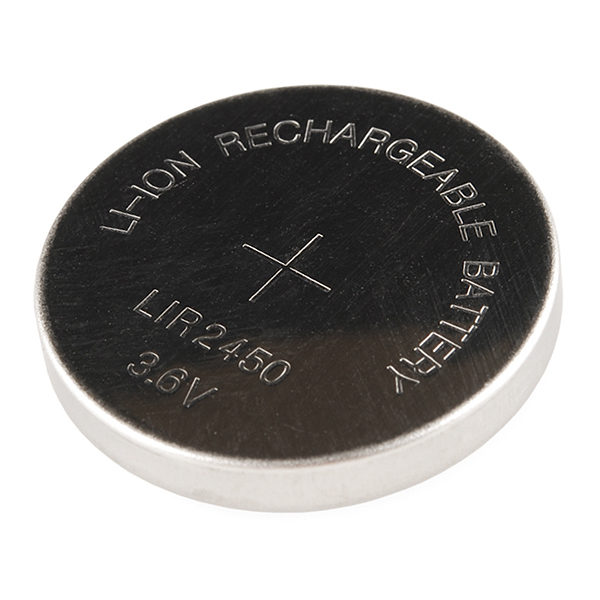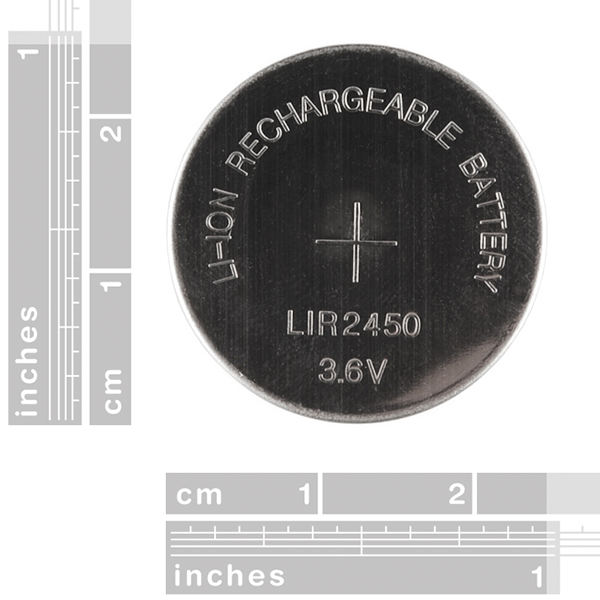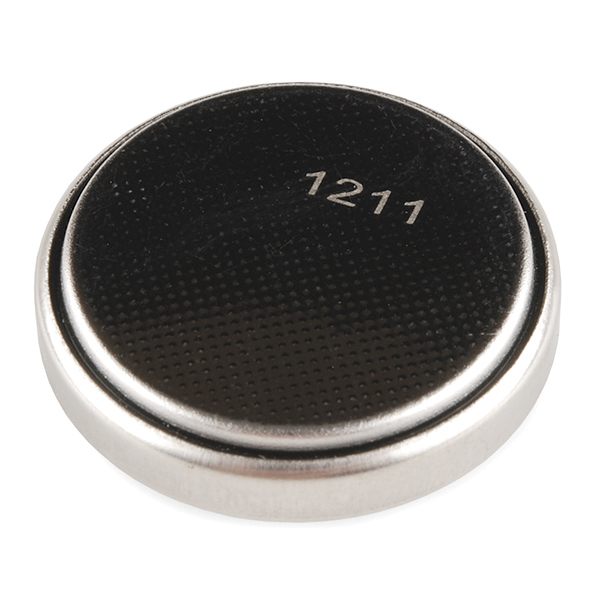Coin Cell Battery - 24.5mm (Rechargeable CR2450)
A really cool rechargeable Lithium Ion coin cell battery. The battery is rated for 3.6V @ 110mAh - a great way to run a small embedded project for hours. This battery is a standard CR2450 battery size.
Note: This battery is not available to ship to Alaska or Hawaii, or through any express services (2-day, overnight), or internationally. This is temporary! Check out our blog post for more information. Additionally orders may take longer to process and therefore do not qualify for same-day shipping. Sorry for any inconvenience this may cause!
Note: This item is non-returnable. If this item arrives damaged or is not functioning properly, please do not hesitate to contact us to see if further actions may be taken.
** Weight: **6.4g
- 24.5x5.2mm
- [Datasheet](http://cdn.sparkfun.com/datasheets/Prototyping/Lithium Ion Battery MSDS.pdf)
- MSDS
Coin Cell Battery - 24.5mm (Rechargeable CR2450) Product Help and Resources
Adjustable LiPo Charger Hookup Guide
September 28, 2017
The SparkFun Adjustable LiPo Charger is a single-cell lithium polymer (LiPo) and lithium ion battery charger. Because it’s adjustable, this charger will be able to safely charge all of our singe-cell batteries.
Core Skill: Electrical Prototyping
If it requires power, you need to know how much, what all the pins do, and how to hook it up. You may need to reference datasheets, schematics, and know the ins and outs of electronics.
Skill Level: Noob - You don't need to reference a datasheet, but you will need to know basic power requirements.
See all skill levels
Comments
Looking for answers to technical questions?
We welcome your comments and suggestions below. However, if you are looking for solutions to technical questions please see our Technical Assistance page.
Customer Reviews
No reviews yet.





do we get a charger with this order ....?
-------------------- Tech Support Tips/Troubleshooting/Common Issues --------------------
You can use a MCP73831T IC to charge the LiPo battery. Make sure that you are using a charge rate that is lower than the capacity. There were some comments below that recommends charging at a rate between 37mA to about 55mA. The closest charger that you could use is the LiPoly Charger Single Cell https://www.sparkfun.com/products/12711 since it is easier to change the charge rate from the default 500mA. Most of the other chargers on our storefront use a charge rate of 500mA but it is harder to charge the programming resistor.
Here's an convenient charger for this battery. http://www.theledart.com/blog/?p=1917
Can you guys post a datasheet? I'd like to know the maximum charge and discharge current.
Can you guys get the thinner 3 mm version of this too?
A rule of thumb for most lithium batteries is that you should be safe with anything around 1/3 C or lower for charging and discharging. (C being the amp-hour rating of the battery.) So limit the current in or out of this one to about 37 mA or so. I'd recommend 1/2 C (55 mA) as a maximum. Any more and the overall charge discharge cycle life of the battery will suffer.
A typical charger will first check the battery condition by using a low value test current, then charge for a couple hours or more at a constant current until the voltage reaches the design limit (typically 4.2 Volts). At that point the voltage is held constant and the current is monitored. When it falls to 10% of the main charge current the current is turned off. You must not trickle charge lithium batteries. And usually the temperature of the battery is monitored while charging.
For SFE's basic charger sku: PRT-10217 you'd want to change R4 from 2 kOhms to about 30 kOhms.
This is for plain vanilla lithium batteries.
There are batteries for RC cars and copters and such that can handle 10C, 20C or more, and folks are working on batteries for cars that can be charged at 100C (essentially taking the same amount of time it takes to fill a gas tank).
Can you provide the correct datasheet for this battery? Or at least a datasheet that is specific to this battery? The current datasheet provided has no mention of the LIR2450, and is not relevant. Thanks!
I am looking for a way to make a charger for this, the charger its self can be however big it needs to be. I personally would like to make two charge modes, one at about 40mah and another at half that maybe less. Basically one that would charge it in maybe 3 hours and another that would charge it over night. would a MAX1555 IC work for this purpose? Would I be able to limit the output current from this to the desired mah? or would it not work in that sense?
If I'm reading this datasheet right, we charge these at 4.2V, even though they operate at 3.6V nominally. Is this correct? It's making me a bit uneasy.
ok I couldn't find and answer for this here. what sparkfun chargers would work with this battery ? if its the MCP73831T then do i need to set the charger from 500mA to 100mA ?
does anyone make a vertical coin cell holder for this battery?
I am looking for reference design that can charge both rechargeable coin-cell and LiIon/LiPo battery. I saw a design by Jay about 6 months ago. Can I use this design for both rechargeable coin cell and LiPo (not in parallel or concurently)?
I designed a charger for these if anyone is interested. You can check it out and download the files at my site. I'm not set up for commerce, but can sell you one if you email me. Have 90 bare boards if you want to solder them yourself.
That link is broken, but I believe this is the same post: http://chasingtrons.com/main/2012/3/26/cr2450-coin-cell-charger.html
So which is the best way to recharge this battery? I own an PRT-10161.
Thank y
hi, I just got 2 of these, my question is, do I have to charge them before the first use or do they come already charged like Lead-Acid batteries?
I'm not fully sure but most Li-Pos come with a "Storage Charge" of about 70% of the battery's capacity.
Can this be used in the Costco 'wind-up' flashlight? the one on it has died.
Is there any data sheet available for this product? And what battery holder will be best for these batteries?
We don't have a data sheet for the battery specifically, but here are the basic characteristics:
LIR2450 Li-ion battery
Norminal voltage: 3.6V
Norminal capacity: 160mAh
Approx weight: 6.5g
Wide temperature range from -20C to +60C
It would be useful for me (and I suspect most average hobbyists) if Sparkfun sold a battery holder for this part that doesn't need to have a circuit board attached to it in order to work. When I'm prototyping I use wires- lots of wires...
Of course, a break-out board for PRT-08863 would work too.
BOB-10495 is such a board!
I am not an expert by any means, but I built a circuit with the battery this one replaces and a MAX1555 charger running an Atmega328. The intention was to ensure the Atmega kept running during occasional power outages, in order to correctly preserve time (RTC design with async Timer2 and 32.768kHz crystal)
The circuit only ran for six months (I replaced it with a new design that does away with the rechargeable batt), and it ran extremely well. Along this time it had at least one three-hour power outage every day. But it being so little time, I can't tell whether the charger chip wrecked the battery's lifecycle or something.
Prior to assembling my circuit, I did some tests on a breadboard (holding the battery between right-angle headers and using a SOT-23 to DIP adapter for the charger), and also got good results re charging time, voltages, etc. (none of which, I admit, I checked over the final PCB)
Important: I only used the USB input of the MAX1555, never the DC one.
My application is similar to yours, rjimenez, and like you I am concerned with damaging the cell long-term. My impression is that lithium ion cells are happiest when they are not under continuous charge. If they are allowed to 'relax' to about 3.9 or 4.0V they seem to last longer than if they are held at 4.2V for long stretches of time (I'd appreciate CaptainKirk's comment on that ... wait, did I really just say that ?) I am going to set up a little testbed where I have extra diodes coming from the MAX1555 GND to ground and from the BAT pin to the cell under charge. I figure if the Vf's are different I can detune the max charging voltage by 0.1 or 0.2V.
Can this beauty be charged with LiPoly Charger sku: PRT-00726 ??.
This charger is based on the MAX1555 instead of the MCP73831T, as does the sku: PRT-10217.
In my opinion it looks as it doesn't, because the MAX1555 says it is for Lipo only, and MCP73831T is for both Lipo and Li-Ion.
It is a bit confusing, because the MAX1555 charger appears in the "Related Products" section of this button cell, but the Sparkfun recommendation is for the MCP73831T instead (see other comments).
Anyway, an expert statement on this would be well received.
The MAX1555 has a minimum of 100 mA charge current, or almost a 1C charge rate. You could do it, but the battery life will probably suffer. I don't see any easy way to reduce the current.
this could be great on the arduino fio.
Any idea why this one is 110mAh and the old one with the same physical size was 200mAh?
all batteries can range in capacities. their energy density can vary quite a bit for the same size package. for instance, compare an energizer or duracell battery to the cheapest off-brand you can find. they are both AA, but the 'better' ones have more capacity.
i'd agree with Member30927, it doesn't seem to make sense that you're selling a worse battery (from your description) for the same price because you got a better supplier ? What up, thx!
nice! ill buy one asap ... Hope it stays in stock!